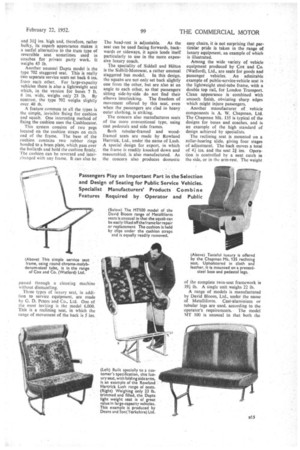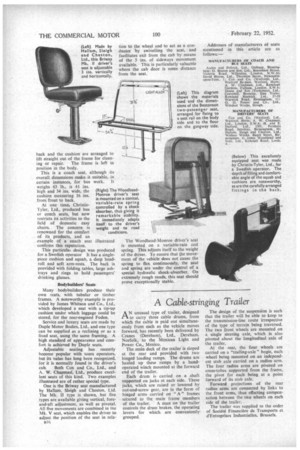SEATS
Page 48

Page 49

Page 50

If you've noticed an error in this article please click here to report it so we can fix it.
of the Mighty
SEATS are, in a rattier inverted way of speaking, the pre-occupation of most passenger-vehicle operators to-day. Larger vehicles have increased the seating capacity of fleets to a marked degree, but a current line of thought is .that there should be fewer seats in buses and coaches, to provide either more standing room or greater comfort. The question is one of topical importance.
Operators have, of course, always had to devote much time and thought to the question of seating in buses. Claims departments can produce evidence of this in the form of demands for damages filed by passengers. These arise from fingers broken in inadequate hand-grips, hands scratched by protruding rivets, clothes torn on rough framing or soiled on cushions.
The variety is almost endless, and may in some part be countered by the claims that the bodybuilding staff of any undertaking might make against the public for seats slashed, screws thoughtfully removed, upholstery soiled, ashtrays collected, and many other public foibles which have to be accepted, like wear and tear, as legitimate items of running costs.
What Users Expect
The cost of providing the public with what it wants in the way of seating is extremely high. Seats must be clean, attractive and comfortable, otherwise the mighty—and far from mute—figures in the traffic statistics will express their disapproval. They must also be easy to repair and clean, light in weight, simple to install and possessed of lone-wearing characteristics.
The possibility of a small manufacturer succeeding in meeting all these requirements, in conjunction with the large-scale output needed to keep initial cost low and to fill some of the extensive orders now current, especially for export, is slight. It must be remembered that an order for 900 buses entails a demand for approximately 18,000 sets of seat frames, cushions and squabs..
To deal with such a situation, a number of established manufacturers took the far-seeing step of forming, after the war, a Bus Seat Frame Association to produce a standardized range of products. Technical resources. patents and experience were pooled B14
with good effect and the Association can provide rapid delivery against the largest order.
Members of the Association are Accles and Pollock, Ltd., Deans and Sons (Yorkshire), Ltd., G. D. Peters and Co., Ltd., and I.W.H.T. (Siddall and Hilton), Ltd. The range of seats is known by the name of Dapta, although each company also manufactures its own special types.
All the seat frames are constructed of oval, chrome-molybdenum butted tubing and are available in almost any design as standard, high-quality, production units. No fewer. than 20 varieties of top rail are standardized, for example. Upholstery is interchangeable between all the service-bus seats and legs, pedestals, brackets or support struts are available to enable the seats to be fitted in any body.
Fashioned for Luxury
Apart from the service seats, which are most attractive and comfortable, because of the care and experience expended on their design, there are also express-service and coach seats in the Dapta range. There are adjustable, fixed, staggered, individual, reversible and swivelling models in standard production. The semi-coach seats have proved popular in double-deck express service buses.
One of the Most luxurious seats produced by the Association is the Dante reversible type 36, made by Accles and Pollock, Ltd., which is a patented design, based on a steel-tube "frame. This particular seat has a single U-shaped cushion, filled with Dunlopillo, which pivots about . a point beneath the arm-rests. Thus, both seat and squab alternate when the unit is facing forwards and rearwards respectively, ensuring long life.
Although it is 31A ins, wide overall, and 311 ins, high and, therefore, rather bulky, its superb appearance makes it a useful alternative to the tram type of reversible seat sometimes used in coaches for private party work. It weighs 45 lb.
Another unusual Dapta model is the type 702 staggered seat. This is really two separate service scats set back 6 ins. from each other. For large-capacity vehicles there is also a lightweight seat which, its the version for buses 7 ft. 6 ins, wide, weighs only 23 lb. By contrast, the type 702 weighs slightly over 40 lb.
A feature common to all the types is the simple, invisible fixing for cushion and squab. One interesting method of fixing the cushion uses the Cushlocator.
This system consists of two pegs located on the cushion straps on each end of the frame. The base of the cushion contains two rubber rings bonded to a brass plate, which pass over the bollards and hold the cushion firmly, The cushion can be reversed and interchanged with any frame. It can also be passed through a cleaning machine without dismantling.
Three types of luxury scat, in addition to service equipment, are made by G. D. Peters and Co., Ltd. One of the most inviting is the model 6,000. This is a reclining seat, in which the range of movement of the back is 5 ins.
The head-rest is adjustable. As the seat can be used facing forwards, backwards or sideways, it again lends itself particularly to use in the more expensive luxury coach.
The speciality of Siddall and Hiatus is the Sidhill-Isloreseat, a rather unusual staggered bus model. In this design, the squabs are not only set back slightly one from the other, but are also at an angle to each other, so that passengers sitting side-by-side do not find their elbows interlocking. The freedom of movement offered by this seat, even when the passengers are clad in heavy outer clothing, is striking, The concern also manufactures seats of the more conventional type, using cast pedestals and side frames.
Both tubular-framed and woodframed seats are made by Rowland Ilartrick, Ltd., under the name of Lush. A special design for export, in which the frame is readily knocked down and reassembled, is also manufactured. As the concern also produces domestic easy chairs, it is not surprising that particular pride is taken in the range of luxury equipment, an example of which is illustrated.
Among the wide variety, of vehicle equipment produced by Cox and Co. (Watford), Ltd., are seats for goods and passenger vehicles. An admirable example of public-service-vehicle seat is the lightweight steel-tube frame, with a double top rail, for London Transport. Clean appearance is combined with smooth finish, obviating sharp edges which might injure passengers.
Another manufacturer of vehicle components is A. W. Chapman, Ltd. The Chapman Mk. 135 is typical of the designs for buses and coaches, and is an example of the high standard of design achieved by specialists, The reclining seat is mounted on a roller-bearing slide, giving four stages of adjustment. The back moves a total of 4}, ins, and the seat 21 ins. Operation is controlled by a neat catch in the side, or in the arm-rest. The weight of the complete twin-seat framework is 39i lb. A single unit weighs 22 lb.
A range of models is manufactured by David Bloom, Ltd., under the name of Metalliform. Cast-aluminium or tubular legs are used, according to the operator's requirements. The model MT 100 is unusual in that both the back and the cushion are arranged to lift straight out of the frame for clean ing or repair. The frame is left in position in the body.
This is a coach seat, although its overall dimensions make it suitable, in certain instances, for bus work. It weighs 63 lb., is 41 ins. high and 34 ins, wide, the cushion measuring 16 ins. from front to back.
At one time) ChristieTyler, Ltd., produced bus or coach seats, but now restricts its activities to the field of domestic easy chairs. The concern is renowned for the comfort of its products, and an example of a coach seat illustrated confirms this reputation.
This particulat design was produced for a Swedish operator It has a singlepiece cushion and squab, a deep headroll and soft arm-rests. The back is provided with folding tables, large ashtrays and rings to hold passengers' drinking glasses.
Bodybuilders' Seats Many bodybuilders produce their own wets, with tubular or timber frames. A noteworthy example is provided by lames Whitson and Co., Ltd., which developed a seat with a tip-up cushion under which luggage could be stored, for the rear-engined Foden.
Service and luxury seats are made by Duple Motor Bodies, Ltd., and one type can be supplied as a reclining or as a fixed seat, using the same framing. A high standard of appearance and comfort is achieved by Duple seats.
Adjustable seating has recently become popular with tours operators, but its value has long been recognized, for it is normally found in the driver's cab. Both Cox and Co., Ltd., and A. W. Chapman, Ltd., produce excellent seats of this kind. Two examples illustrated are of rather special type.
One is the Briway seat manufactured by Hallam, Sleigh and Cheston, Ltd. The Mk_ II type is shown, but five types are available giving vertical, foreand-aft adjustment, as well as pivotal. All five movements are combined in the Mk. V seat, which enables the driver to adjust the position of the seat in rela e16
tion to the wheel and to act as a conductor by swivelling the seat, and facilitates exit from the cab by means of the 5 ins, of sideways movement available. This is particularly valuable where the cab door is some distance from the seat..
The Woodhead-Monroe driver's seat is mounted on a variable-rate coil spring. This adjusts itself to the weight of the driver. To ensure that the movement of the vehicle does not cause the spring to flex continuously, the seat and spring are under the control of a special hydraulic shock-absorber. On extremely rough roads, this seat should prove exceptionally stable.
Addresses of manufacturers of seats mentioned in this article are as follows:—
MANUFACTURERS OF COACH AND BUS SEATS
Accles and Pollock, Ltd., Oldbury, Birmingham; G. Beaton and Son. Ltd., Beatonson House, Victoria Road, Willesden, London, N.W.10; David Bloom, Ltd., Thornton Street, Newcastleupon-Tyne, 1; Cox and Co. (Watford), Ltd., Watford By-pass, Watford, Hens; A. W. Chapman, Ltd., Kanelagh Gardens, Fulham, London. S.W.6; Deans and Son (Yorkshire), Ltd,. cirrovebin. Beverley, East 'Yorks: Rowland Marwick. Ltd., 57-59 Warwick Road, Birmingham, 11: G. D. Peters and Co., Ltd., Windsor Works, Slough.
MANUFACTURERS OF DRIVERS' SEATS
Cox and Co. (Watford), Ltd., Watford, Hem A. W. Chapman, Ltd., London, S.W.6; H. and E. Mallard, Ltd., 1501. Pershare Road, Sarchley, Birmingham, 30; Hallam, Sleigh and Chcston. Ltd.. Widney Works. Bagot Street, Birmingham. 4; Jonas Woodhead and Sons, Ltd., Kirkstall Road, Leeds,




















































































